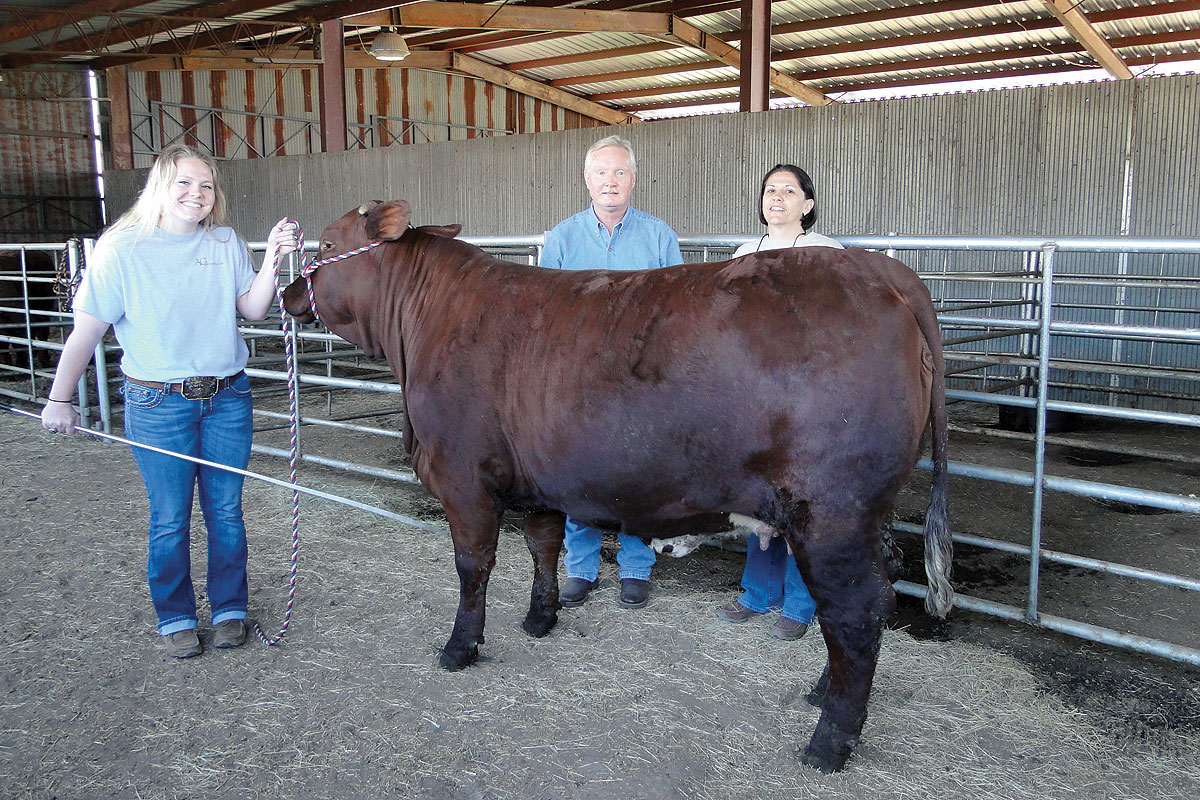
Taylor Farms located in St. Joe, Ark., is a study in breeds. Brent and Robin Taylor, along with Brent’s parents, Duford and Rosalee Taylor, manage more than 1,400 acres on an extended family farm and have one registered and two purebred herds, as well as a commercial herd. In addition, their daughter Emmalee, who is in college and planning to be a large and small animal veterinarian, is developing another registered herd while their other daughter, Westin, is in law school. The farm’s herds are Santa Gertrudis, black Angus, Red Angus and Red Charolais.
The farm’s goal is to produce a moderately framed commercial cow, size 5 or slightly above, with a mature weight of 1,200 to 1,300 pounds. The cow must also be sustainable on grass.
“I want to have a commercial herd with animals that look identical, just like a package of Oreos: when you open them, they all look the same,” Brent said.
Taylor Farms’ genetic manipulation began in earnest with grandfather Rovell Yancey. Grandmother Mary Jane gardened and ran a grade C dairy herd with a 50-50 Jersey/Holstein cross for additional income. Until 1970, the couple bred their cows to whatever bull they had. That year everything changed when a man named Dr. Williams introduced the Santa Gertrudis breed to the area with cattle he purchased from the founder of the breed, the King Ranch in Texas.
Santa Gertrudis is the first American created breed and is composed of 5/8 Shorthorn and 3/8 Brahma. The breed was officially recognized in 1940 by the United States Department of Agriculture with desirable characteristics, including calving ease and milking ability as well as more parasite resistance, more heat resistance in spite of their thicker hair, and an ability to tolerate fescue entophyte fungus common in local pastures. Because local cattlemen could not afford the high-priced animals, Dr. Williams allowed neighbors to simply choose a bull for their home operations. Rovell was one of those neighbors.
The results were amazing. Rovell’s next spring calf crop had an increased weaning weight of 100 pounds and were also more acceptable to backgrounders because of the calves’ parasite resistance, heat resistance and fescue tolerance.
What Rovell and Mary Jane observed was that the Santa Gertrudis cross calves grazed while others rested in the shade. Because a Santa Gertrudis bull produced excellent commercial cows and heifers, as well as desirable calves, the commercial side of their business improved.
According to Brent, Santa Gertrudis became the first purebred Taylor herd and the only registered herd because most of their customers are commercial cattlemen who care more about performance than registration papers. Ten years later, Brent and his father, Duford, purchased two bulls to use with their own Hereford/Angus cross cowherd. In 1985, five papered Santa Gertrudis heifers entered the organization and became the seed stock for today’s registered herd.
Next the Angus Association made black hided cattle dominate the industry, resulting in the Taylor’s adding a purebred Angus herd in their quest for the most profitable commercial cow. Of course the Angus herd provided and still provides breeding stock for cattlemen wanting that prized black hide.
“We got closer to our goal for a profitable commercial cow in terms of genotype and phenotype but not close enough,” Brent said.
Meanwhile, Brent had always loved red cattle and began a purebred Red Angus herd. A black Angus bull bred a Red Angus cow by accident and the combination worked.
“That chance occurrence got us much closer to what we were trying to achieve,” Brent said.
Now there’s a new breed on the block that Brent believes may be the answer: Red Charolais.
Through careful breeding, Charolais have made great strides in severely limiting birthing issues while maintaining excellent growth and muscle. Red Charolais are pure Charolais rather than a cross with red breed. Charolais possess color but have a diluting gene, which means only a few calves are born red. These were gathered to become a separate type with the Red Charolais bred for more length and depth with added performance. Brent believes the Red Charolais appear to possess a better temperament.
“Red Charolais may be the commercial cattlemen’s dream,” Brent said.
This is where daughter Emmalee enters the picture. During a Northwest Arkansas District Fair, Emmalee met Larry Julian at the wash rack.
A retired music teacher, Larry now promotes Red Charolais both for production and showing and explained he can’t meet the demand. Emmalee and Larry have entered into an arrangement supported by a Farm Services Credit youth loan whereby Emmalee buys embryos for transplant. She then keeps the heifers while Larry buys back the bull calves. Her first six transfers were successful and produced five heifers and one bull. Brent feels growing a starter herd of 15 to 20 mommas through this arrangement has the potential to produce a highly profitable income stream.
Two other practices highlight Taylor Farms. One is turning show animals into pasture animals, which the Taylors have found to work extremely well for them. The second practice is directly related and calls for flushing cows for eight to 10 number 1 or number 2 embryos before sending them to the sale barn.
“Our cows, whether show animals or not, work for us. We do not work for them,” Brent said.






